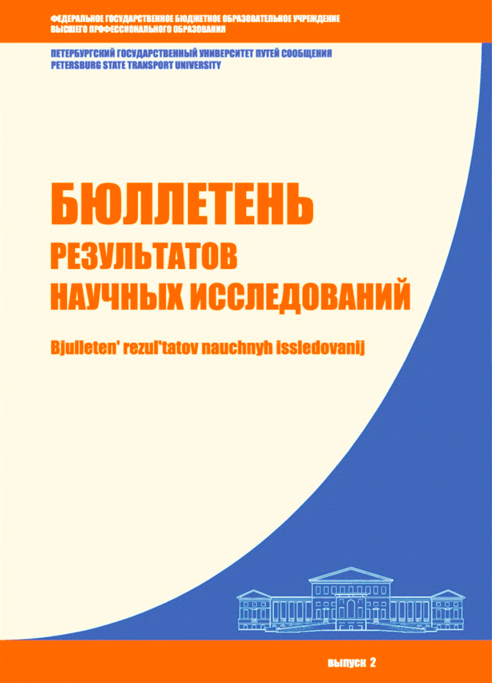Russian Federation
Russian Federation
Purpose: To investigate the water-holding capacity of granite crushed stone ballast, with a stone fraction ranging from 5 to 25 millimetres. Methods: The experimental procedure was conducted within a designated container to ascertain the water-retention capabilities and degree of water saturation of granite crushed stone that is used as the primary material in the construction of railway tracks. Laboratory tests were conducted utilising varying percentages of clogging agent, ranging from 5 to 25 millimetres (10%, 20, 30, and 40% by mass of aggregate), within the grain composition of the crushed stone. Results: The test results demonstrate that clogging of crushed stone with particles ranging from 5 to 25 mm does not exert a significant influence onits water-holding capacity and degree of water saturation. In the presence of up to 40% by weight of clogging agent with a size of 5–25 mm in the crushed stone grain, the moisture content increased by no more than 0.4%, and the degree of water saturation did not exceed 0.04 p.u. (percentage unit) in conditions of an active railway track. Practical significance: The clogging of crushed stone in a track ballast layer with 5–25 mm-size fractions and a mass percentage of up to 40% has negligible impact on the water-holding capacity and degree of water saturation. This phenomenon does not exert a substantial influence on the reduction of strength and deformation characteristics of the crushed stone.
Railway track, granite crushed stone, ballast prism, clogging of crushed stone ballast layer, water retention properties, degree of water saturation
1. O Strategii razvitiya zheleznodorozhnogo transporta v Rossiyskoy Federacii do 2030 goda: Rasporyazhenie Pravitel'stva RF ot 17.06.2008 № 877-r // Konsul'tantPlyus: spravochnaya pravovaya sistema. — URL: https://www.consultant.ru/document/cons_doc_LAW_77643/ (data obrascheniya: 03.02.2025).
2. SP 238.1326000.2015. Svod pravil. Zheleznodorozhnyy put': utverzhden i vveden v deystvie prikazom Ministerstva transporta Rossiyskoy Federacii 06.07.2015 № 209. — M.: MGUPS (MIIT), 2015. — 71 s.
3. Kolos A. F. Zasorenie i zagryaznenie schebenochnogo ballasta pri ekspluatacii zheleznodorozhnogo puti / A. F. Kolos // Izvestiya Peterburgskogo universiteta putey soobscheniya. — SPb.: PGUPS, 2022. — T. 19. — Vyp. 3. — S. 558–575.
4. Popov S. N. Ballastnyy sloy zheleznodorozhnogo puti / S. N. Popov. — M.: Transport, 1965. — 183 s.
5. GOST 7392—2014. Scheben' iz plotnyh gornyh porod dlya ballastnogo sloya zheleznodorozhnogo puti. Tehnicheskie usloviya. — M.: Standartinform, 2015. — 32 s.
6. Ishikawa T. Influence of Water Content on Shear Behavior of Unsaturated Fouled Ballast / T. Ishikawa, S. Fuku, T. Nakamura, Y. Momoya et al. // Procedia Engineering. — 2016. — Vol. 143. — Pp. 268–275.
7. Qian Y. Moisture Effects on Degraded Ballast Shear Strength Behavior / Y. Qian, D. Mishra, E. Tutumluer, Y. Hashash et al. // JRC2016. — 2016. — P. V001T01A034.
8. Kolos A. F. Nesuschaya sposobnost' i deformiruemost' ballastnogo sloya pri eksplu tacii zheleznodorozhnogo puti: dis. … d-ra tehn. nauk / A. F. Kolos. — SPb., 2014. — 637 s.
9. Ebrahimi A. Deformational behavior of fouled railway ballast / A. Ebrahimi, J. Tinjum, T. Edil // Canadian Geotechnical Journal. — 2024. — Vol. 52. — Pp. 344–355.
10. Tutumluer E. Laboratory characterization of coal dust fouled ballast behavior / E. Tutumluer, P. Associate, P. Kent, W. Dombrow et al. // Journal of the Transportation Research Board. — 2008.
11. Kosenko S. A. Prichiny otkazov elementov zheleznodorozhnogo puti na poligone Zapadno-Sibirskoy zheleznoy dorogi / S. A. Kosenko, S. S. Akimov // Vestnik SGUPS. — 2017. — № 3(42). — S. 26–34.
12. Lim V. L. Mehanika povedeniya zheleznodorozhnogo ballasta: dis. … d-ra tehn. nauk / V. L. Lim. — Nottingem: Nottingemskiy un-t, 2004. — Na angl. yaz.
13. GOST 33057—2014. Dorogi avtomobil'nye obschego pol'zovaniya. Scheben' i graviy iz gornyh porod. Opredelenie sredney i istinnoy plotnosti, poristosti i vodopogloscheniya: mezhgosudarstvennyy standart. — M.: Standartinform, 2016. — 13 s.
14. GOST 25100—2020. Grunty. Klassifikaciya: mezhgosudarstvennyy standart. — M.: Standartinform, 2020. — 41 s.









